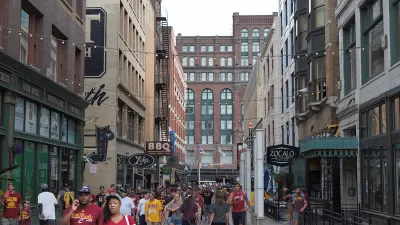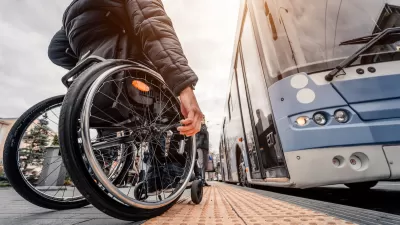A new study assesses which cities have the broadest access to walkable neighborhoods.

Urban planners frequently tout the benefits of walkability. But as Kea Wilson explains in Streetsblog USA, for many households, walkable neighborhoods just aren’t affordable. A new study sheds light on how walkability interacts with affordability. “Perhaps unsurprisingly, the researchers found that Americans on the whole will pay significantly more for the privilege of living in a place where they can get around on their own power: specifically, 35 percent more for home buyers, 41 percent more for apartment renters, and 44 percent more for office properties.”
According to an analysis from Smart Growth America, the city with the most equitable walkability in the United States is Cleveland, Ohio. According to Michael Rodriguez, visiting director of research at SGA, “Cleveland was at one point the fourth largest city in the U.S., and if you look at old images and videos of it, it was [as] vibrant as midtown Manhattan. These were proper cities, and we chose to enact policies that decimated that — but whatever we have left still provides a core of walkability today.”
“Perhaps shockingly, notoriously expensive New York City actually ranked second on the Social Equity Index, which he attributes to its proportionally high median incomes, astounding diversity, and the sheer preponderance of transit and people-oriented places that make car-free living possible for virtually everyone; residents of Manhattan, after all, spend an average of 37 percent of their income on housing and transportation combined, while residents of car-oriented Indianapolis spend 42, according to the Housing and Transportation Index.”
Wilson admits that New York City is an outlier, a megacity with many wealthy residents, but argues that equitable access to walkable communities shouldn’t be an anomaly. It could be part of every city if more effort was made to “implement zoning reforms, foster non-automotive travel, and invest in affordable housing for all.”
FULL STORY: America’s Most Equitably Walkable City is … Cleveland?

Study: Maui’s Plan to Convert Vacation Rentals to Long-Term Housing Could Cause Nearly $1 Billion Economic Loss
The plan would reduce visitor accommodation by 25,% resulting in 1,900 jobs lost.

North Texas Transit Leaders Tout Benefits of TOD for Growing Region
At a summit focused on transit-oriented development, policymakers discussed how North Texas’ expanded light rail system can serve as a tool for economic growth.

Why Should We Subsidize Public Transportation?
Many public transit agencies face financial stress due to rising costs, declining fare revenue, and declining subsidies. Transit advocates must provide a strong business case for increasing public transit funding.

How to Make US Trains Faster
Changes to boarding platforms and a switch to electric trains could improve U.S. passenger rail service without the added cost of high-speed rail.

Columbia’s Revitalized ‘Loop’ Is a Hub for Local Entrepreneurs
A focus on small businesses is helping a commercial corridor in Columbia, Missouri thrive.

Invasive Insect Threatens Minnesota’s Ash Forests
The Emerald Ash Borer is a rapidly spreading invasive pest threatening Minnesota’s ash trees, and homeowners are encouraged to plant diverse replacement species, avoid moving ash firewood, and monitor for signs of infestation.
Urban Design for Planners 1: Software Tools
This six-course series explores essential urban design concepts using open source software and equips planners with the tools they need to participate fully in the urban design process.
Planning for Universal Design
Learn the tools for implementing Universal Design in planning regulations.
Ascent Environmental
Borough of Carlisle
Institute for Housing and Urban Development Studies (IHS)
City of Grandview
Harvard GSD Executive Education
Toledo-Lucas County Plan Commissions
Salt Lake City
NYU Wagner Graduate School of Public Service





























